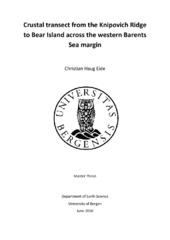Crustal transect from the Knipovich Ridge to Bear Island across the western Barents Sea margin
Master thesis
Permanent lenke
https://hdl.handle.net/1956/4027Utgivelsesdato
2010-06-08Metadata
Vis full innførselSamlinger
- Department of Earth Science [1050]
Sammendrag
A crustal model of a 322 km long transect from the Knipovich Ridge to Bear Island (Bjørnøya) has been obtained by use of reflection seismic data and wide angle Ocean Bottom Seismometer (OBS) data. Further constraints of the model have been provided by gravity modeling. The study is part of the IPY (International Polar Year) consortium Plate Tectonics and Polar Gateways in Earth History". The primary objective is to gain detailed insights into the structure of oceanic crust created by the slow to ultraslow spreading Knipovich Ridge. A secondary objective is to investigate the southern part of the sheared Hornsund margin segment of the Western Barents Sea. The thickness of oceanic crust varies greatly along the profile, from 4 to 8 km. The youngest part of the oceanic crustal layer 2 is dominated by relatively low p-wave velocities of 4.4 km/s, while the older parts with a thicker sedimentary overburden have velocities varying from 5.2 to 6.2 km/s. These variations appear to be correlated to variations in the total crustal thickness. The continent ocean boundary (COB) has been located to a 15 km wide zone, and a new location of the COB is proposed for the area around the line. East of the COB, a downfaulted terrace is identified between the Hornsund Fault Zone and the Knølegga Fault. The Knipovich Escarpment is a prominent feature on this profile, marking a 3 km rise in the oceanic basement over 20 km. It is associated with a shallowing of the Moho, and is interpreted to mark the location of a detachment fault which developed around 10 Ma or later.
Utgiver
The University of BergenOpphavsrett
The authorCopyright the author. All rights reserved
